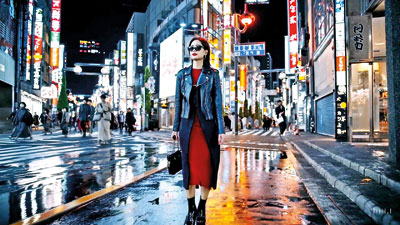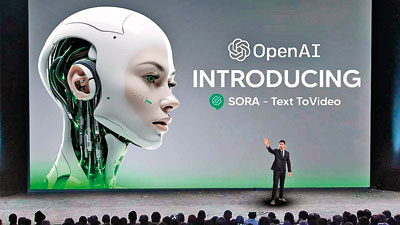OpenAI launches Sora: You prompt, it creates
View(s):By Mahesh de Andrado
With the advent of AI tools such as ChatGPT and DALL-E 2, creators have been given a plethora of new and interesting tools for content creation. For example, you can now create chapters in a novel, movie scripts, and even organizational documents with the use of ChatGPT. Looking for a more artistic approach? DALL-E 2 enables visual artists to create realistic images from natural language text prompts. You basically type in what sort of image you want to create, right down to the colours, theme, art style and elements you want, and the AI will create it for you.

A demo video created by Sora showing a a woman in a red dress and black leather jacket walking down a street in Tokyo (Image Credits: SamMobile)
Recently, OpenAI launched their latest in the line-up of AI Tools aimed at video creation. Called Sora, the tool basically takes text prompts, and uses it to generate videos up to one minute in length, whilst maintaining impressive visual quality and complying with the user’s instructions. While other video generation tools from the likes of Meta and Google exist or are in development, they’re not as detailed as Sora.
OpenAI’s website for Sora boasts a number of videos that the company notes were created by Sora, ranging from “A stylish woman walks down a Tokyo street filled with warm glowing neon and animated city signage. She wears a black leather jacket, a long red dress, and black boots, and carries a black purse. She wears sunglasses and red lipstick. She walks confidently and casually. The street is damp and reflective, creating a mirror effect of the colorful lights. Many pedestrians walk about”, to “Historical footage of California during the gold rush”, to a “Tour of an art gallery with many beautiful works of art in different styles.”

Meet the latest addition to OpenAI; Sora (Image Credits: YouTube)
In terms of generating content from Sora, OpenAI states that the model is currently only available to red teamers who are “domain experts in areas like misinformation, hateful content, and bias — who will be adversarially testing the model”. OpenAI also goes on to state that they are developing tools to aid in the detection of misleading/fake content by means of a detection classifier, which can positively identify if a video was generated by Sora. OpenAI will also be strictly following C2PA (Coalition for Content Provenance and Authenticity) guidelines as well as use the existing safety methods applied to DALL-E which reject inappropriate or harmful text prompts.
The technology isn’t perfect and Sora’s webpage makes note of it, stating that the technology “may struggle with accurately simulating the physics of a complex scene, and may not understand specific instances of cause and effect. For example, a person might take a bite out of a cookie, but afterward, the cookie may not have a bite mark”. It also goes on to explain that “the model may also confuse spatial details of a prompt, for example, mixing up left and right, and may struggle with precise descriptions of events that take place over time, like following a specific camera trajectory.”
There’s also the ethical and legal conundrums when it comes to AI generated content. For example, with DALL-E 2 and ChatGPT, there can be instances when the datasets and models used are based on an artist’s work, and the artist was not compensated for their work and that the model also violates that artist’s copyright. Furthermore, using AI generative tools can also harm an artist’s ability to support themselves with their work, as corporate entities can take undue advantage of the technology.
While OpenAI has pledged and is determined that their AI tools will not be misused, there’s always a chance that the technology can be used for political mudslinging and even harm to a person via deep fakes of sexually explicit content.
Training these models can also lead to an increased carbon footprint. While we don’t really think about it, training these models to improve their accuracy also takes a significant amount of energy (electricity, water etc), which can also be harmful to the environment and incur huge maintenance costs.
At the end of the day, OpenAI’s Sora tool does open up a new world of possibilities for video content creators. But it also poses a fair number of questions and potential flaws and vulnerabilities. How these can be solved remains to be seen in how OpenAI handles it.
Searching for that next furry family member but couldn’t find one in your area? Hitad.lk has the solution with our extensive listings of dogs for sale in Sri Lanka!


